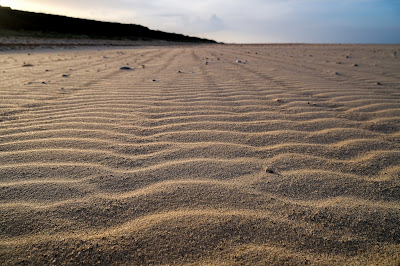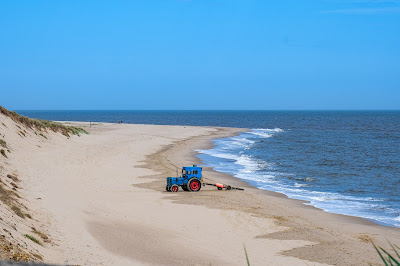Seaside Special - That California feeling: South Norfolk
If I’m not careful, the theme of caravan parks and holiday villages will end up dominating these posts. Because here I go again. Only this time, I stayed on one. How’s that for irony?
As England staggered along a chilly lockdown road map in April and May 2021, I realised that there was a sizeable space in the material I’ve begun to publish. The shape of the interval aproximated to that of the south Norfolk coastline. Norfolk as a whole has one of the longer arcing coastlines of all English counties. Stopping the narrative at Cromer in the previous post seemed a bit half-hearted.
I engineered a small gap of my own in the working week to steal a visit eastwards. Though having left the planning of the jaunt late, and needing an overnight stop, I found myself accommodationally challenged. Not much was available, and I guessed that easing hospitality restrictions had prompted a rash of bookings as Britons quite rightly sought freedom and sea air. Or that the hospitality sector was not yet geared up for bookings, waiting instead for restrictions to be fully eased.
 |
| Hemsby beach |
Alan, my airbnb host, told me on the phone that there was no WiFi in the chalet and that the electricity needed to be fed with £1 coins through the meter. I was travelling back in time.
Another hangover from the pandemic has been the switch to cashless living. Which is why I found myself scrabbling round the house trying to find the right coinage for Alan’s time machine electricity provider. I located two. At Liverpool Street station I decided to pay for lunch with a crisp tenner newly acquired via an old-fangled cashpoint so that £1 coins would appear in my change. This proved rather more challenging than anticipated. First the self-service till told me I’d bought the wrong snack for the meal deal. I had to go back for a different packet of crisps. Next, the cost of a meal-deal was an even fiver (I had not noticed until then), which would mean an absence of coins in my change. Finally I added a magazine and brought the total to over £7. The change spilled in to the tray: a £2 coin and some shrapnel. Useless. So I used the coin to buy a KitKat at a kiosk outside.
The chalet was everything I hoped it would be. It looked classically 70’s from the outside and I was immediately transported to childhood holidays in exactly these sorts of campsites in Berwick, Morecambe and here in Norfolk, just up the road at Hemsby. The park covered substantial acreage with the neat, no-frills accommodation laid out in little squares or rows of three or five grouped together, with plenty of green space in between. Very typical of the era. When the final reckoning comes for holiday parks, places like this should be heritage-listed. Probably.
 |
| That 1970's feeling |
- The immersion heater
took an hour to warm up; the triple-arm kitchen ceiling light stopped
flickering if you fiddled with the dimmer for a bit; and the electric fire only
rattled for the first few minutes or so.
- He lived alone, had spilled chocolate chip ice-cream down his front when I rang about 20 minutes previously (a-ha!); and his hip was giving him gyp so he didn’t walk much these days.All functional though and at the price, no complaints at all. I only had to chuck a single hard-won quid in the meter all stay.
My enthusiasm for the chalet, I discovered, was mainly confined to its exterior appearance and the park layout. Inside, a few defiant touches of 70’s styling remained, like the fitted kitchen cupboards and sliding doors between the rooms. The remainder was a hotch-potch of cheap refits reaching the end of their life. There was no avocado bathroom suite to marvel at, sadly.
All functional though
and at the price, no complaints at all. I only had to chuck a single hard-won quid
in the meter all stay.
There was not much open in the way of facilities at California Sands Holiday Park. The expansive site had a swimming pool, amusements, cafes, a supermarket and the substantial Oasis bar/club. Only the garden of the Oasis had been open for a couple of hours earlier in the day.
I had better luck down by the slipway to the beach and scoffed a healthy portion of fish and chips at Trisha’s Chippy, before exploring up the coast. I was keen to see what Hemsby looked like these days. The walking was slow going in soft sand, but I had the beach pretty much to myself, save for gulls skimming the low-breaking waves and plovers skittering in and out of the wash, legs moving so fast they blurred like Scooby-Doo’s escaping a fake ghost. The setting sun turned the flat sand into a slideshow of wind-whipped ripples and shifting shadows.
 |
| self-portrait |
A shopping, food and entertainment centre had been developed at Newport, a few hundred yards east of the village, to service the tourist population. This was also much bigger than in my mind’s eye. But the real eye-opener was how quiet everything was. Most bars and boutiques had not bothered opening at all since the first hospitality and shopping restrictions had lifted in April. The pubs, despite decent sized beer gardens remained locked up. I saw a few signs giving opening dates of the following weekend which, for some schools would be the start of the Whitsun half-term. Maybe a few places – particularly the amusement arcades and funfair rides opened at the weekends. But that Wednesday night at 8.30pm everything was bolted down and silent. A ghost town.
This lonely and eerie site hammered home the unbalanced impact of pandemic restrictions. In Berkhamsted, an affluent middle-class town, people had come out in droves to sit in pubs and restaurants with plush patio furniture and outdoor heaters. Here, in a settlement almost entirely dependent on overnight stays, I reckoned that no more than 10-15% of the never-ending caravans and chalets were occupied. The scenario would be different at the weekend, no doubt.
Hemsby is well known for its rolling sand dunes, but they are currently covered in green netting, forbidding access, because they are falling down. The residential segment is known as The Marrams. They have suffered significant erosion in recent years. There were fewer than 40 homes left here now, as opposed to 240 homes 50 years ago, according to the site owners. On the beach I saw evidence of recent falls in the fence panels and sections of brick wall half buried in the sand. At the back of St Mary’s Road, a for sale sign hung outside a beach shack about 12 feet from the crumbling lip of the dunes. How much for a bolt hole that might be in the sea in a couple of years’ time? Well Bycrofts of Great Yarmouth were asking for £95,000. ‘Listen to the lap of the waves’, said the blurb.
Any chance of avoiding those waves actually crashing in to the living room from the bottom of the dunes largely rested on the building of permanent works to protect the rest of the homes. The Environment Agency was looking at a scheme put forward by the local authority, but it depended on justifying public funding based around the number of households that would be protected.
One chalet called Dune Falls (pun presumably intended) was surrounded by a concrete skirt dug deep in to the fragile cliff. I couldn't see how that would help if the land either side gave way.
Walking back to California along the cliff-top Seaview Road. Home owners had become more confident by Scratby where the dunes were replaced by a slightly more stable sedimentary base and consequently the buildings were constructed of brick and stone, rather than board and plank. The views back up the coast as the sun dipped below the horizon were uplifting. If only I could find an open pub beer garden. Instead I navigated through the sea of chalets and caravans back to my residence and watched the electricity meter wind down for an hour or so.
 |
| Above Scratby |
The place had other things going for it too. Pretty village with a couple of pubs, shops and restaurants, an attractive lighthouse overlooking the sea and yet more dunes. The lighthouse was surrounded by curious, pastel-painted round bungalows that were part of a hotel complex.
The dunes had significant chunks roped off, as at Hemsby, to combat erosion, protect habitats and promote regrowth. A bloke in Trisha's chippy the previous evening had told me about the old cafe at Winterton which had to be taken down before the shifting dunes took it for themselves.
 |
| Winterton dunes |
I walked Winterton’s beautiful beach as far as Horsey Gap. I was hoping to see the grey seal colony there. Despite wandering the paths through rolling dunes and amongst tufted grasses, none were identified. The tide was in, which may have been the problem. However, I took lots of pics of low-lying elongated rocks, just in case.
 |
| Winterton church |
But I had run out of time. Lingering in Winterton meant I had cut down my return train options. I managed a cup of tea near the stump of Brittania Pier, which no longer reached the sea, and noted how the gorgeous beach gave way to crown green bowling lawns overlooked by a lap dancing club. Here was the British seaside in a nutshell for you! Great Yarmouth was busy compared to everywhere else on that trip. A disorientating gear-change for my wound-down brain and it was no hardship to be heading home.
Previous episode: Vintage seasides
Next post: the genteel Suffolk coast.



Comments